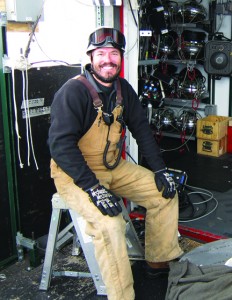Richland Center: Weds, April 24
You might think that Wisconsin winters are tough, with the snow, cold, and early sunsets. While that is true, Wisconsin resident Jim Haugen escapes the winter here by traveling to a place that is sunny 24 hours a day but rarely gets over negative ten degrees Fahrenheit – the South Pole in Antarctica.
 On Wednesday, April 24, Haugen will be in Richland Center talking about what it’s like to work at the South Pole and how he helped build the IceCube Neutrino Observatory, one of the world’s largest and most interesting telescopes.
On Wednesday, April 24, Haugen will be in Richland Center talking about what it’s like to work at the South Pole and how he helped build the IceCube Neutrino Observatory, one of the world’s largest and most interesting telescopes.
“It’s great to share this project with people,” says Haugen, who was responsible for making sure that the construction at the South Pole was completed on schedule. “It was such a success and Wisconsin people and companies contributed in a big way to make it happen.”
The April 24th campus and community events are part of a statewide program funded by the Ira and Ineva Reilly Baldwin Wisconsin Idea Endowment Foundation and Wisconsin IceCube Particle Astrophysics Center (WIPAC), a University of Wisconsin – Madison research center.
From 12:00pm to 1:00, Haugen will give a talk in Pippen Hall at UW – Richland Center. Since it’s over the lunch hour, you are welcome to bring your lunch. Refreshments and desserts will be provided.
In the evening, he will be back in Pippen Hall at 7:00pm for “Extreme South Pole Science,” a public, all ages talk about how and why IceCube was built.
Haugen will also be the keynote speaker at Richland Center Wisconsin Alumni Association Founder’s Day dinner. Local alumni coordinator Robert Bellman is enthusiastic about the event, saying, “People will be excited to hear how Wisconsin is involved in such a huge project in such an exciting place. Having a public event after the alumni dinner is a great way for us to connect with the community.”
IceCube, a National Science Foundation project, looks for ghost-like particles called neutrinos, which can travel through the Earth easier than light goes through glass. The entire detector is built into the 2800-meter thick ice sheet at the South Pole.
It took more than a decade and the efforts of an international collaboration of scientists to design, test, and build IceCube. The worldwide effort is rooted squarely in Wisconsin with key partners at the University of Wisconsin–Madison and staff and suppliers from around the state.